Lois Dodd has been painting her everyday surroundings for sixty years. Her current exhibition, from February 26 through April 4, 2015 at the Alexandre Gallery in NYC shows twenty-four recent small-scaled paintings that depict familiar motifs such as gardens, houses, interiors and views from windows. Dodd, now eighty-seven, is an iconic figure of the early New York Tenth Street art scene, along with her contemporaries, such as Alex Katz and Philip Pearlstein. The Alexandre Gallery has the current exhibition online as well as many earlier works for view that you can view from this link.
The late painter Will Barnet talked about Lois Dodd in an interview with Barbara O’Brien. (From the Kemper Museum catalog, Lois Dodd Catching the Light)
…”What she has is something that belongs to the language of painting that actually only a very few artists really understand and know about. She has that feeling that the flatness of the canvas, and the verticality or the horizontality has to be met in a certain dynamic way. And she can arrange her forms so that the verticals become alive in relationship to the horizontal. So there is a certain wedding of the two. And so her work has a structure that you miss in most painters. In other words, you have a feeling of solidity and that the forms really belong to each other, where they’re in the distance or in the front. They combine in such a way that they come together and form a whole picture, and that’s what is exciting about—one of the exciting things—Lois.” –Will Barnet
With a career that spans six decades, Dodd is a member of the American Academy of Arts and Letters and the National Academy of Design, and a past member of the board of governors for the Skowhegan School of Painting and Sculpture. Among many honors, she recently was awarded the Benjamin West Clinedinist Memorial Medal in 2007 from the Artists’ Fellowship, Inc. and Cooper Union’s Augustus Saint-Gaudens Award for professional achievement in art in 2005. Her works can be found in museums, including the Portland Museum of Art, Maine and the Kemper Museum of Contemporary Art, Kansas City, Missouri, among others.
The excellent catalog, Lois Dodd Catching the Light can be purchased from the Kemper Museum of Contemporary Art from this link. This catalog is from her Kemper Museum retrospective where more than fifty paintings were shown from 1955 to 2010.
I wish to thank both Lois Dodd for agreeing to the phone conversation and for her time and thoughtfulness with answering my questions and to share her experience and ideas with our readers.
I would also like to thank Elizabeth O’Reilly for the many ways she helped make this possible.
Larry Groff: Do you spend a lot of time looking and thinking about the subject before you start to paint?
Lois Dodd: It’s more about what I see when I’m walking around looking for something. Then after that it a matter of what size I want to work with and the proportion it will fit into. Then I try to isolate something that would make a good painting, a good subject. I look through my pile of gessoed panels that are different sizes and different proportions. They are all rectangles or squares and I always take a few of those when I go out so I have a variety of panels to choose from because that is the first decision. If you’re looking at something you want to paint and it looks exciting, the lighting is good and then you have to decide what size what shape of a panel will it fit onto; you ask yourself, is it a horizontal thing or vertical or square. Those are the first choices.
LG: How do you start a painting? Do you make studies or thumbnails first? Do you use a viewfinder of some sort?
LOIS DODD: I don’t really use a viewfinder but I can put my hands up to frame the view or something like that. I don’t make thumbnail sketches, I’m more interested in starting right on the panel. I start with thinned out yellow paint and draw with the brush. So it’s pretty minimal, general and not tight. You asked me if I scrape off, I don’t use a scraper but I don’t use heavy paint either I really paint rather thinly so we never get to the point where I can scrape. But if I don’t like what I’ve done I can rub it off with a rag with turpentine and rub it all around and then I have a nice colored ground to work into that I can use.
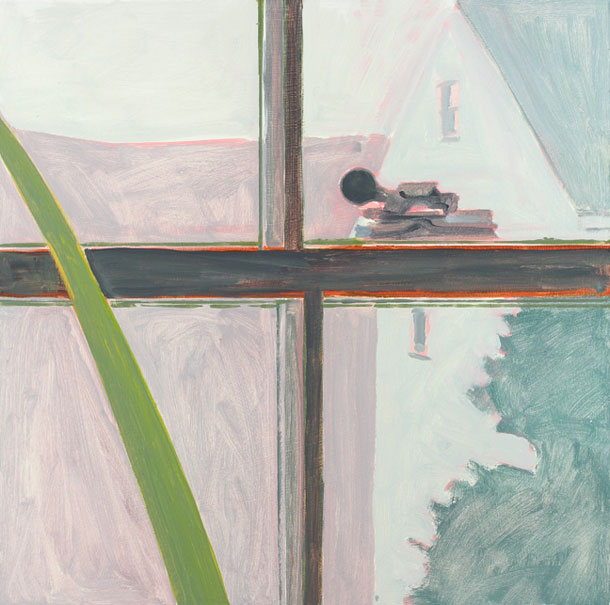
WINDOW CROSSPIECE 2014 oil on masonite 12 x 12 inches ©Lois Dodd, courtesy Alexandre Gallery, New York
LG: When you find the motif that interests you; do you form the composition in your mind before you start? Or is it something that evolves from your prolonged looking at the thing?
LOIS DODD: I do see a geometric breakdown of space of the rectangle so it has an underlying geometric structure so that is pretty basic to what I’m looking at.
LG: but the rest of it: the color scheme, the mood, the positions of things; they sort of evolve?
LOIS DODD: No, the position of things, that configuration, is what attracts me and what I find exciting to begin with, so I don’t move things around. They’re either already where I want them or I might get up and move my chair and easel, it might be a little better a couple feet this way or that way. What I’m looking at more or less dictates the composition. I don’t really take any liberties with the subject, if it’s no good to begin with, that’s it.
LG: Do you measure things to get everything right in terms of the relationships between things?
LOIS DODD: No, Did you see that film about that painter in Madrid, Antonio Lopez Garcia? Speaking of measuring?
LG: Victor Erice’s Dream of Light http://en.wikipedia.org/wiki/Dream_of_Light
LOIS DODD: Yes, do you remember where he’s standing in front of the tree and marking where his feet are going to be and where the leaves are and all of that? I’m certainly not doing that but I’ll move few inches this way or that before I start if I don’t like what I’m getting at. Standing or sitting down makes a big difference too. Once my position is set it’s usually fine.
LG: So it isn’t as important for you to pursue getting the underlying grid of horizontal and vertical geometric relationships? Is it more that you want to get the overall feeling or pictorial expression of the thing you first saw, your first impression of why you were attracted to the motif?
LOIS DODD: Yes. It’s the way the light is hitting the subject and is creating the composition. The big thing is my paintings are done in one sitting; partly because of the light and partly because of the weather. I can only be there a couple of hours because after that the light changes the whole composition. The sun will have moved and everything is different in two or three hours so my paintings needs to be done in that time.
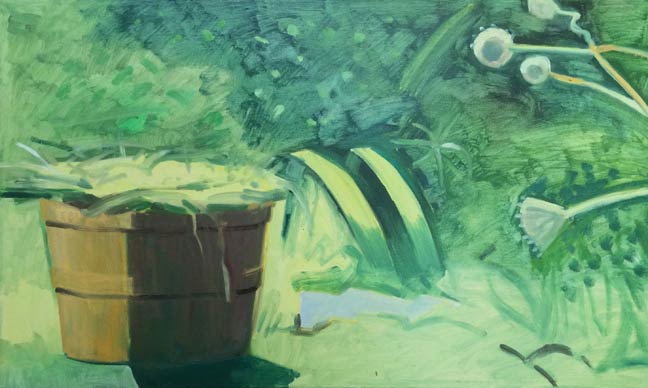
3 BUSHEL BASKET + IRIS LEAVES 2014 oil on masonite 12 x 19 7/8 inches ©Lois Dodd, courtesy Alexandre Gallery, New York
LG: Do you use larger brushes and smooth surfaces so you can work quickly and broadly?
LOIS DODD: My panels are up to 15 by 20 inches or smaller panels that are 12 by 18 or 12 by 12. I have a whole pile of gessoed panels, they’re not huge, 20 inches is largest I would go, as larger Masonite panels tend to warp or be weird. They aren’t reliable when they get too big. Once the painting is bigger I paint on linen.
LG: You also work on aluminum panels?
LOIS DODD: The little tiny ones are aluminum step flashing that you can get in the hardware store.
LG: Step flashing? I’m not familiar with that.
LOIS DODD: Step flashing is for putting flashing down the bottom of a chimney where it goes under the roofing material to keep water out. That’s what they’re made for and they come in these really small sizes. You can buy big bundles of the stuff for very little money.
LG: What a great idea! Do you gesso these?
LOIS DODD: It’s a very good idea. I sand them like mad because I think they’re too smooth and then I gesso them.
LG: What kind of gesso do you use?
LOIS DODD: I use Liquitex usually. Step Flashings are very convenient when you see something and you’ve got 20 minutes. I do a lot of them at night when the moon is full.
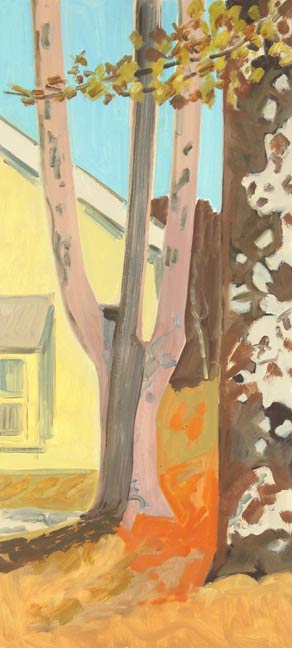
TWO TREES, AFTERNOON LIGHT 2014 oil on masonite 18 3/4 x 8 5/8 inches ©Lois Dodd, courtesy Alexandre Gallery, New York
LG: You must simplify things a great deal to get everything in one sitting.
LOIS DODD: Of course, I’m not looking for details or surface description that’s for sure. But I am looking for the light, how it hits volumes. I am looking for the light and the color.
LG: Is what you’re looking at the main concern or do you also think about how other art might relate to your scene? For instance, if you were painting a scene and thought ‘this reminds me of an Arthur Dove painting’ or someone like that would you ever push it in that direction a little? Or does all that great art history in your head come through more intuitively?
LOIS DODD: I think so, sometimes you see things that are like somebody else’s painting so you stay away from it. Have you ever had that experience where you think, ‘oh my god this looks like something so-and-so would paint’? So I’m not painting it. It’s somebody else’s subject matter.
LG: Interesting. So you wouldn’t want to do your take on that subject?
LOIS DODD: Well, if you don’t notice that it’s someone else’s subject, definitely, you’re always doing your own take. Sometimes I see things that looks like other people’s paintings but that’s not interesting to me to begin with. It’s not for me.
INTERVIEW CONTINUES
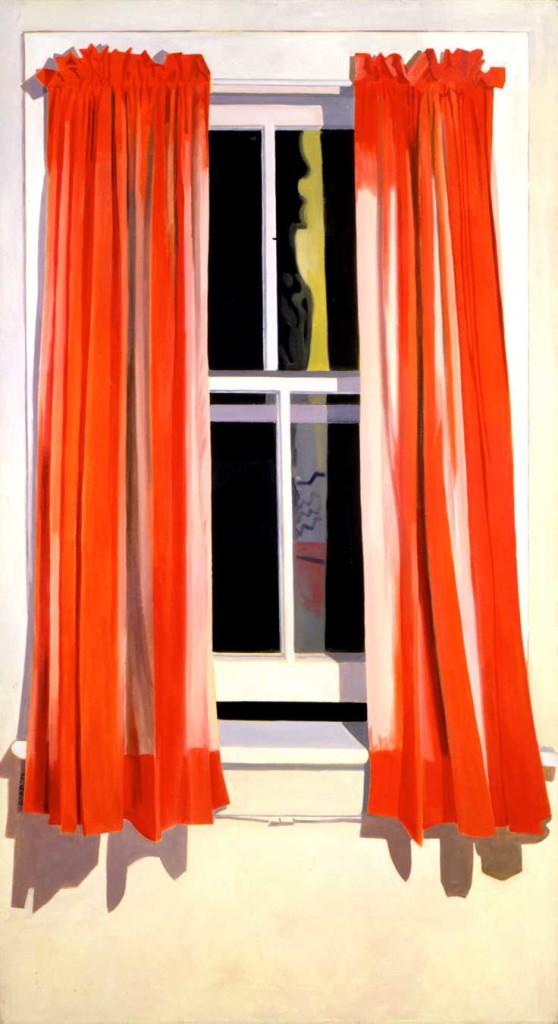
NIGHT WINDOW – RED 1972 Oil on linen 66 x 36 inches ©Lois Dodd, courtesy Alexandre Gallery, New York
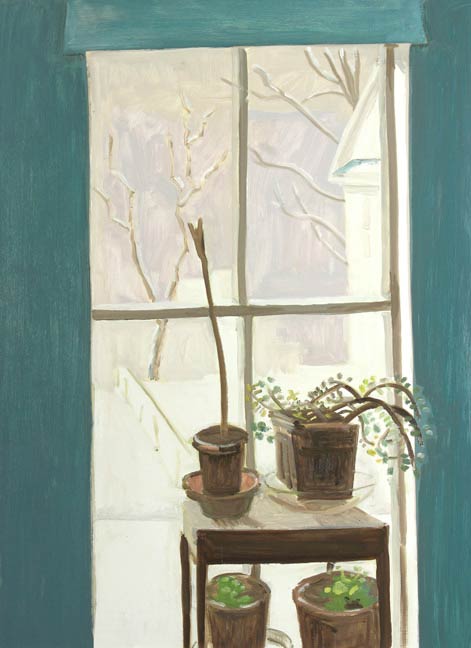
SNOW LIGHT – FEBRUARY 20 2014 oil on masonite 5/8 x 15 inches ©Lois Dodd, courtesy Alexandre Gallery, New York
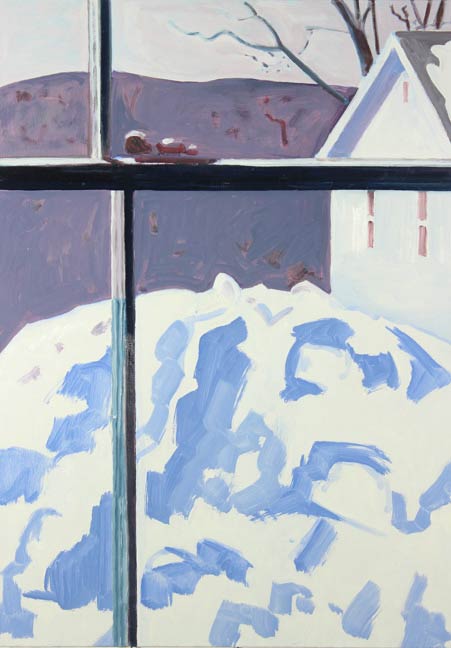
PORCH ROOF SNOW PILE 2014 oil on masonite 20 x 14 inches ©Lois Dodd, courtesy Alexandre Gallery, New York
LG: What tends to grab you most as worthy subject for a painting? For instance you’ve painted windows for a long time.
LOIS DODD: That’s true; I’m still painting windows. This winter I’ve been doing a lot of painting out the window because of the weather and the window structure is so nice, you’ve got this perfect Mondrian construction there in front of you. Windows are a great device and are endlessly fascinating. I do go back to them from time to time.
LG: When you’re working on a painting is there a point that you arrive when you know this is exactly what you want and the painting is done or is it more like the time is up and this is what I’ve accomplished. Do you adjust it once back in your studio or do you not touch it? How do you determine when the painting is finished?
LOIS DODD: Usually when I put the last stroke down it’s done. There is nothing more to say; there is nothing more to put down. It’s pretty clear. It’s not a problem of when to stop; if I start dickering around with details I know that ok “you’ve gone over the top, now you got to stop”.
I was doing portraits for a couple of years of friends, they weren’t really portraits, I thought of them as heads. I wouldn’t want to promise anybody I could paint his or her portrait. In the process of doing that, I would work for a couple of hours and I would have my painting and I would think I could really perfect this now if I worked on it longer. But if I did that it would no longer be my painting, it would be fixing my painting. It would be repairing, trying to improve and that doesn’t really work. The minute I start doing that it starts taking apart or destroying what I already had to say. So it doesn’t work, for me. The work ethic is not a good ethic is what I’m trying to say.

REFLECTED LIGHT ON BRICK WALL, DECEMBER 2014 oil on masonite 18 x 15 3/4 inches ©Lois Dodd, courtesy Alexandre Gallery, New York
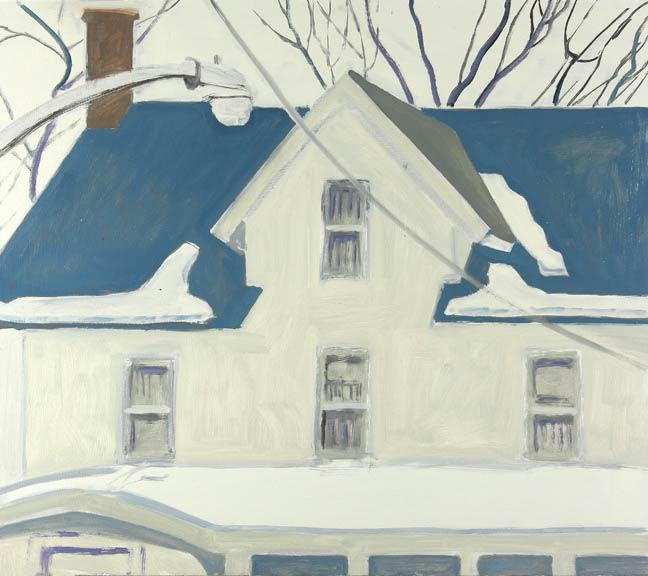
PORCH ROOF SNOW PILE 2014 oil on masonite 20 x 14 inches ©Lois Dodd, courtesy Alexandre Gallery, New York
LG: You qualify that by saying “for me”, another painter who might obsessively revise and repaint you might not have a problem with? You might still like their work?
LOIS DODD: Oh yes. Sure. I think it’s a mystery. Every artist works so differently out of something so different. It’s very hard to understand what even your best friends, what they’re doing and how they got their palette, and how they selected the color. The whole thing is always a big mystery. But you can certainly enjoy and appreciate what other people do. What I envy are people that ladle the paint on thickly and juicily. I see that and think that’s so gorgeous, just look at the paint quality. But here I am with my thin paint and the idea of putting on a second coat on my painting would ruin it. It would shut out the light. I get a certain amount of light that is coming back from the white gesso panel , it comes through the painting. If I go back and put more than one coat then you’re suddenly in the position of having to paint light into surfaces. It is a completely different process and that just doesn’t work for me.
LG: I’ve read you don’t like setting up still lifes and prefer to find things as they naturally occur. With this in mind I’m curious about your thoughts on Morandi. His carefully arranged still lifes have a pictorial genius that would seem to have many affinities with your work especially with regards to intimacy, simplicity and directness of organization. His landscapes could almost be considered found still lifes from nature.
Has his paintings ever been influential to you? What can you say about his work?
LOIS DODD: Morandi hasn’t been an influence on me but I love his painting; they’re wonderful, so amazing, they are surprises every time. I’ve looked at his landscapes and I think their influence is in keeping it flat, keeping it simple. That seems to be the message in his landscapes. All of his paintings are wonderful but he’s probably not the person who has been that influential to me.
LG: Who would be influential?
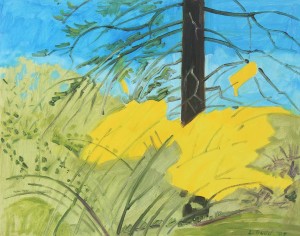
FORSYTHIA, APRIL 2007 oil on masonite 10 1/4 x 13 inches ©Lois Dodd, courtesy Alexandre Gallery, New York
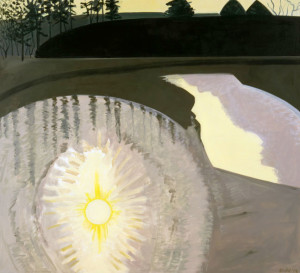
WINTER SUNSET, BLAIR POND 2008 oil on linen 48 x 52 inches ©Lois Dodd, courtesy Alexandre Gallery, New York
LOIS DODD: That’s a good question. I look at all the American landscape painters but I probably look even more at the abstract landscape people. Like Arthur Dove and John Marin. I look at a lot of stuff. I don’t feel like I’m besotted with anybody that I would try to imitate what they do. I don’t think that is a good idea to be totally in love with so-and-so’s painting. No matter what you do, you have to make your own stuff. Influences are great but they’re not too useful really.
LG: But perhaps you would be influenced by the issues other painters were exploring? For instance, Cezanne, you might not be interested in painting like him but you might be interested in what he was thinking about?
LOIS DODD: I don’t know what he was thinking about. I have no idea what he was thinking about! (laughs) He definitely was an influence, especially when I was first out of art school. I think we all looked at Cezanne, he was perhaps the biggest influence for landscape. Between him and Picasso. When I graduated from art school Picasso was the big person who influenced everything that was going on. Back then there was Cezanne and Matisse. There are so many good painters. It was French painting that people looked at most. I remember the galleries uptown when I was in art school; the few galleries there were basically showing French impressionist paintings. The big move to open galleries came sometime in the fifties.
LG: You were one of the founders of the influential Tanager Gallery, one of the first artist coop galleries around Tenth St. Alex Katz, Philip Pearlstein, Fred Mitchell, Lester Johnson were among the many artists who showed there. These galleries were influential as they gave opportunities for a wider variety of art to be seen than just what was seen in the more conservative 57th street area galleries.
It must have been exciting with Willem de Kooning, Franz Kline and Milton Resnick having studios nearby and where many younger artists sought them out at the nearby Cedar Tavern. Alice Neel, Paul Georges, Lester Johnson, Al Held and many others were showing in the various other coop galleries that started there soon after yours. The art critic Harold Rosenberg, wrote in 1959, said that the purpose of the “the art colony on Tenth Street’ was to “transmute the ranks established by social class into a hierarchy based on talent or daring.”
I’m curious to hear what that time was like for you. Can you share a memory of one of your more influential meetings or events with some of the luminaries of that era?
LOIS DODD: As you say it was a very exciting time, we were running our own show, so to speak and made a gallery out of it. We first started on Fourth Street and were there about a year. It was a tiny place. Then a friend told us about a space on Tenth St that was bigger so we moved. Around the same time other galleries began opening. The Hansa Gallery opened and gradually the block filled up with galleries, even around the corner. There was a lot of going back and forth to the galleries and the activity of people going in and out and talking about the art. It was a very social scene for about ten years there, from 1952 to 62.
The Tanager was there from ’52 to ’62, other galleries came a little later and lasted longer. There is nothing there now; it is very close to where I live so I walk through that block every so often. It’s unbelievable how it has completely become another place.
LG: How would you compare the co-op galleries that exist today in Chelsea with the original co-ops from back then?
LOIS DODD: We closed up after ten years because it looked like the galleries uptown were beginning to look at our generation of people. A number of the people that were a part of our group got themselves uptown galleries. We started asking why are we doing all this work, painting the floor, painting the walls, keeping the door open and tending to this place when it looked like the world was opening up and we could all get galleries for ourselves and not have to do all this work. So we closed up. But actually, newer co-ops opened within seven or eight years. I think the uptown gallery scene wasn’t all that great as it turned out and people did the co op galleries all over again.
The thing is there are never enough galleries and if you want to have a show and you know other people in the same situation you can try to do it yourself. That was an exciting time. People came there and talked about stuff. The artist’s club was nearby. We used to have openings on Friday nights and then people would tend to go to the club and hear the panels. So the whole thing was a real community effort.
The art world was smaller back then. In the end you knew every artist in New York City except maybe for the uptown-type people. That was a different world.
LG: The Cedar Tavern was nearby I’ve read, did you meet a lot of the personalities that went there, like de Kooning?
LOIS DODD: They had studios in the same block we had the gallery in. I never went to the Cedar Street Bar myself but we saw them in the galleries. All those people would visit.
LG: Were they open to talking to young painters?
LOIS DODD: Oh sure. Sure. Guston was around before he moved upstate. Franz Kline was there some. de Kooning moved out to the country at a certain point. At least before they became really famous. I think the trouble started when their paintings became worth real money and had uptown galleries and then the evils of jealousy and backbiting entered the picture. And you would see some people not being very happy about other people’s success and the like. But up to a point it was great.
It was always interesting but by ’62 we felt like we’ve done this long enough and we don’t need it anymore so we stopped then. But the next generation had the same problem, they again started a number of co-ops and their co-ops, interestingly enough, are still in existence over in Chelsea. The ones in Chelsea now started up probably in SoHo, The First Street Gallery was originally down at First Street on the Bowery. The Bowery gallery likewise, they were both down near Houston Street on the Bowery. They’ve been in existence a very long time. They started when the members were just out of art school and set up these places. Of course it’s been so long there are other people who are in these galleries now. There is still a real need for co-op galleries.
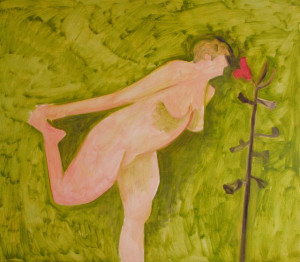
“Nude Sniffing Red Flower” 2010 Oil on masonite, 18 x 20 inches (image courtesy of the National Academy)
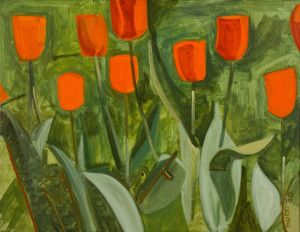
EIGHT RED TULIPS 1980 oil on masonite 14 x 18 inches ©Lois Dodd, courtesy Alexandre Gallery, New York
LG: I was recently in Chelsea and saw many of the galleries. I came away thinking that a large percentage of the work I saw then seemed to have a commercial appeal, seemingly chosen for its marketability or because of fashion. But the co-op galleries this seemed less so. Maybe the paintings there had a more uneven quality but it didn’t have the same commercial appeal.
LOIS DODD: Yes, you’re absolutely right.
LG: I’m curious if you might have anything to say about that? Seems to me that great painting comes more from a freedom to experiment and being about the art rather than just how well will it sell.
LOIS DODD: Many of the galleries in Chelsea are there to be a business. What sells is what they are going to show. That’s something else and has another motivation.
LG: It’s sad though because so many of these sellable paintings have a kind of slickness that is off-putting.
LOIS DODD: Probably a lot of students go to art school with the thought that they can make a living doing art and if they get into that, maybe they can make a living for awhile, but then the fashion in art can change and things aren’t so certain. If you’re in it for the long haul, and get something out of it for yourself. Which is why we do it, then you’ll keep doing it. There are all kinds of art in this world. There is art and then there is painting. I sometimes think it’s split now. There is the “Artworld” that has all this really hot stuff and it isn’t all painting, in fact most of it isn’t painting. There is a lot of other kinds of stuff now. Then there is the world of painters who as always are a kind of medieval group doing their medieval thing and getting something out of it.
LG: I’ve often thought it would be a good idea to start a secessionist movement for painters to get out of the artworld! But people tell me I’m crazy
LOIS DODD: (laughs) There is the art world and there’s painting world and it is two different worlds I agree with you. It’s totally another thing.
LG: Well, it’s what we have so I guess we have to work with it.
LOIS DODD: It’s what we have. Exactly.
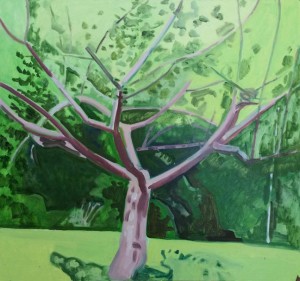
APPLE TREE (PRUNED) 2014 oil on masonite 16 x 17 inches ©Lois Dodd, courtesy Alexandre Gallery, New York
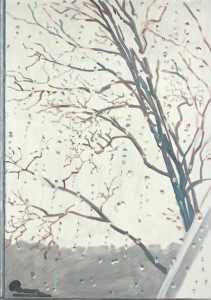
SNOW, TREE, WINDOW 2014 oil on masonite 15 5/8 x 11 inches ©Lois Dodd, courtesy Alexandre Gallery, New York
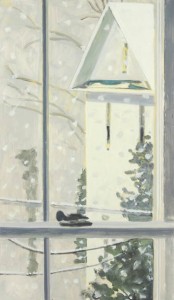
FEBRUARY SNOWSTORM 2014 oil on masonite 19 x 11 inches ©Lois Dodd, courtesy Alexandre Gallery, New York
LG: Many early Abstract Expressionists, such as de Kooning, Pollack, Kline and Rothko had strong traditional skills. How important is being able draw and paint representationally to the making of great art?
LOIS DODD: I don’t think it’s that important that you can draw and paint representationally to make great art. Think of all the great geometric art that exists in the world, the total abstract stuff that there is and it has nothing to do with representing the figure. I’m not so sure that that’s it. It still is a great thing to be studying. The fact of being able to do that is quite wonderful.
I think that sometimes people come out of art schools thinking that they are going to make a living maybe. Maybe that’s what the art schools are after now. They don’t even seem to teach the Bauhaus basic design stuff anymore. Which is what I was getting at Cooper Union when I attended there, they had a basic design course and it was based on the Bauhaus. You came out of school with a vocabulary about line, shape, form and color. All those thing have been separated out now so it is more difficult to study the vocabulary of art and put it together into a painting. The Bauhaus people invented this wonderfully useful thing to study, what, this visual vocabulary. Very good stuff, which I’m not sure is being taught as much anymore.
LG: From what I understand the emphasis is more on art theory.
LOIS DODD: Oh, we’re going to talk art now. Not do it, just talk about it. I’ve always wondered about that. I’m too much of a cave-woman type person to go for that. If you’re working with your hands, we’re hand-workers and you use your head too, of course, but you can’t just use your head; where’s the joy in that for a painter? I guess there is if you’re a theoretician and you’re going to write it down but then you’re a writer that’s not a painter. Maybe that’s an artist, maybe that’s what art is now, right? A discipline for theoreticians.
LG: Sometimes the explanatory text label is more important than the work itself.
LOIS DODD: Remember that period awhile ago, a short movement, where that kind of art was popular, what was that called? Where you just read the art that was on the wall.
LG: With like Jenny Holzer and Barbara Kruger and all those people?
LOIS DODD: Right.

THE YELLOW OUTHOUSE 1999, oil on masonite, 17 5/8 x 14 inches ©Lois Dodd, courtesy Alexandre Gallery, New York

PINK DIGITALIS 2014 oil on masonite 20 x 12 1/8 inches ©Lois Dodd, courtesy Alexandre Gallery, New York
LG: I forget what it was called. I was never very interested in that. One thing you said a minute ago that caught my attention was the word joy.
LOIS DODD: I said that?
LG: (laughs) You said it the context of saying what is the joy in that… I think that is an important thing, there doesn’t seem to be as much interest in joy so much. Or beauty. It’s more about irony or heavy, grim, psycho-sexual, socio-political kinds of issues and there isn’t much room for beauty and joy. I suppose that would be consider passé or sentimental. The whole visual joy one gets from looking at good painting is lost. Is there any fix to that?
LOIS DODD: I don’t know either. Maybe it’s just how much of it you need as a person. Maybe it’s all very individual. Some people seem to get painting and some people don’t see it anyway, they could be surrounded by paintings and don’t really get it. Other people do. It’s an odd trait and it’s not universal. The trait of the visual thing of being able to relate the visual stuff in a way that seems to speak to you.
LG: Do you think that people get it naturally or do they have to study it first?
LOIS DODD: I think it is a natural thing, I remember once I had a painting and a woman who was passing by and saw the painting and really seemed to get it, a sudden reaction. Other people wouldn’t react at all. I think it’s almost physical.
LG: Sometimes I think people just don’t get enough exposure to learning about art in schools anymore, less exposure to art history in a meaningful way.
LOIS DODD: That’s probably true.
LG: But on the other hand people do naturally respond to great things. They see a great painting, like one of your paintings next to something like text art or video and it’s a totally different feeling. It might be intellectually engaging but it doesn’t give you that astonishment, that visual joy or magic.
Do you feel optimistic about painting?

8 Nudes in the Garden 2009-10 oil on linen 25 x 80 inches ©Lois Dodd, courtesy Alexandre Gallery, New York
LOIS DODD: Yes, I do. Look at cave art. Human beings can’t stop doing it. There is always somebody making something. It could go through a low period maybe. No, I don’t think it dies. I don’t think it can. There are always a certain number of people who are just going to have to paint. They have to. I don’t see how it could die.
It’s funny, one time I was over at the Studio School and ran into a woman in the hallway who had just enrolled there and she said that she already had a degree but whatever school she went to they were up to the minute and it was all computers and she hadn’t had a chance to paint and she was dying to try to paint. So she came to the New York Studio School. There are people who just have to try it, have to get into it. I think it must be pretty basic stuff.
LG: It’s a good remedy for many of the world’s ills. It gives you a reason to live.
LOIS DODD: That’s true!
LG: Everything else takes on a secondary importance if you have a great painting you’re working on. Who cares if you have or don’t have all this stuff if you have a good painting?
LOIS DODD: It puts it all in proportion doesn’t it? It makes you able to face whatever it is better after you’ve had a painting session.
LG: Right! Absolutely. You can get all bent out of shape over the headlines in the newspaper but then think “there isn’t much I can do about that” but I do have my painting, I can do something about that. That makes for a great quality of life that can maybe make up for the fact nobody buys your paintings and you live like a homeless person…
LOIS DODD: Yes! Oh god… (laughs) hold on to that thought.
LG: You taught painting at Brooklyn College from 1971 to 1992. How much has what you taught to students affected your own painting and conversely to what extent do you try to teach your own approach to painting to the students?
LOIS DODD: I taught at Brooklyn College for 25 years. I didn’t try to teach my own approach to painting. It wasn’t convenient when your teaching in a college, for the most part we were in a room and I paint outside. There weren’t many opportunities to ask the students to go and buy setups like folding French easels and take them outside. I didn’t do that so it was a completely different experience in the classroom. However it was good, I enjoyed teaching. It was more to try and figure out what they needed not that they should learn to paint like me, which they weren’t going to anyway. They all had their own selves to work on. I wasn’t trying to push my approach. A few people really wanted to do that, a couple of the graduate students that are friends, who I paint with now.
LG: Like Elizabeth O’Reilly?
LOIS DODD: Yes, like Elizabeth. That’s where I met Elizabeth in the MFA program. There are people like that, who keeps in touch. But otherwise I didn’t want them all to be painting like me, that doesn’t seem like a good plan at all. In a way maybe you have more to teach when you teach somebody to paint exactly what you’re doing. Then they can reject it. I don’t know, it’s always been a question in my mind but it’s not my inclination to do that.
LG: What advice would you give a younger painter today?
LOIS DODD: Today there are artists and there are painters. They are two different things and you ought to understand that before you get into it. Artists are not limited to paint, the way painters are. They can do anything they want just about and call it art. It’s a big wide field. But painters are involved in this ancient craft that keeps going on. But I don’t know what advice I’d give anybody. It’s a hard thing to do. If you have to do it, you have to do it. That’s your problem you know? If you have to be a painter you’re going to get the satisfaction out of it that we all get out of it. And you’re going to get the frustration that we all get. And you’re going to have to figure out some other way to make a living. I guess my advice is to figure out some way to make a living.
LG: There are so many people who assume they’ll get a job teaching or something but it’s hard to do
LOIS DODD: There aren’t that many jobs. That’s hard to find.
LG: They don’t always want to hire painters in the art programs either; they often prefer to hire ‘artists’.
LOIS DODD: Yes, Nowadays that is true. Right.
LG: I understand that for many schools the Studio time the students get is much less. They want to have more lectures and fit in more with the academic environment.
LOIS DODD: Right, they want to build up their brains.
LG: I imagine it’s more expensive, it’s likely cheaper to have an adjunct teacher lecturing than it is to fund a whole studio. I don’t know but what that’s going to mean. Before it was almost mandatory you had to go to art school on some level but now it seems such a dicey proposition to shell out 80 or 100 grand for art school and when you come out with such debt, and perhaps not even learning how to really paint on top of that!
LOIS DODD: I don’t know, it really is a strange time.
LG: Have you given workshops?
LOIS DODD: I was doing some up in Maine at Rock Garden Inns. There were people that would come there that wanted to paint outside. So I got invited. Every week they would have another artist come and paint with the people there. So I was doing that for a week in September. That was very enjoyable.
LG: Do you think people can really learn painting through that?
LOIS DODD: Usually they are older ladies who are doing it on their vacation or whatever. They are serious but they also have another life. They can’t dump that life to become a painter. There is no way for the people to give it all up to become painters. It’s a good question but I don’t know what’s going to happen. Whether people will just go study with other painters or maybe the schools will turn around and start going back.
People are still painting at places like the Studio School that is full of painters and drawers. Painting and Drawing that’s basically what they do. And there are some good ones there too. There are a few places but you’d have to know where they are and find yourself getting there.
Lois Dodd talking about her paintings in a 2007 video by Bill Maynes

Snow Covered Outcroppings, 1977, oil on masonite, 15 x 15 3/4 inches ©Lois Dodd, courtesy Alexandre Gallery, New York

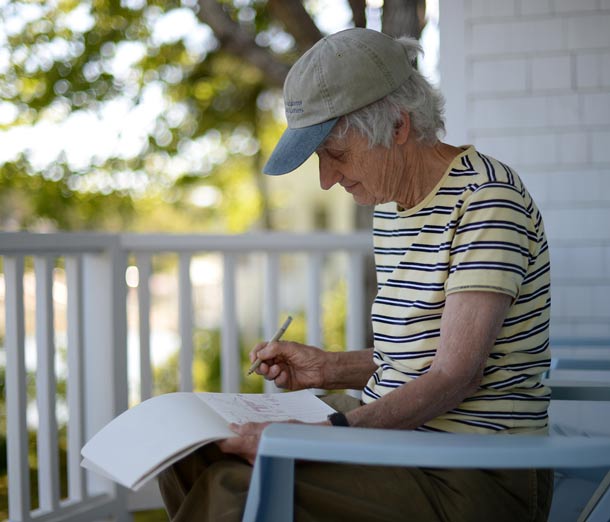
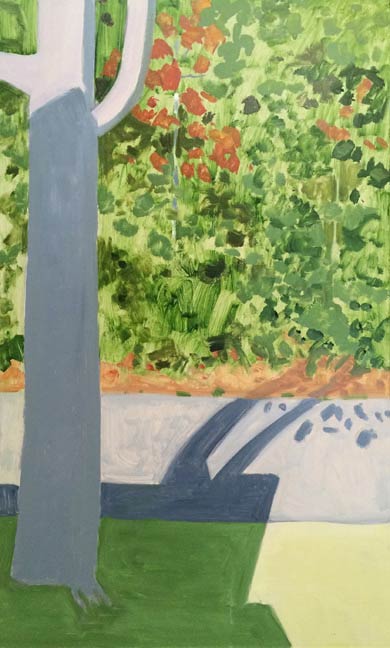
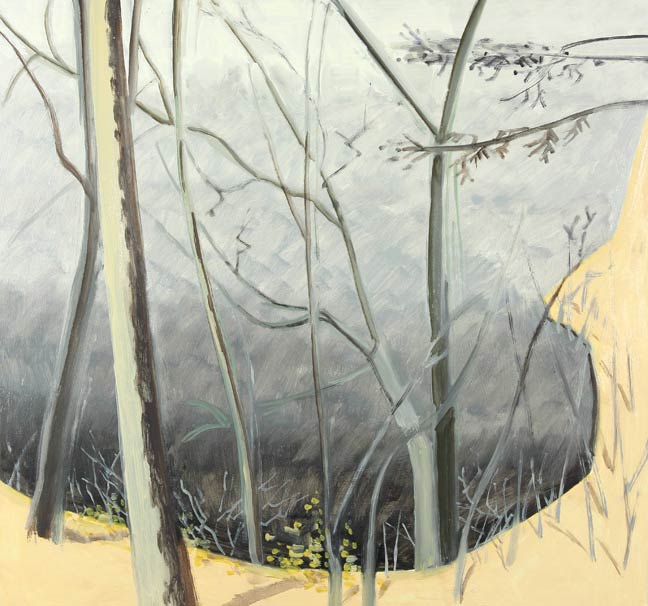
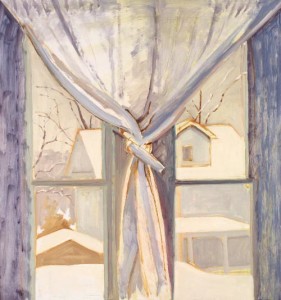
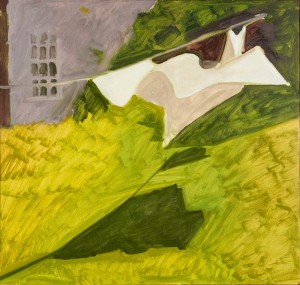
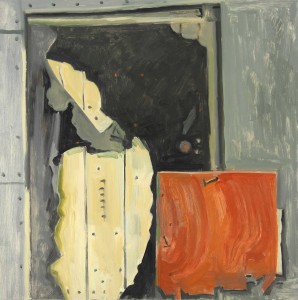
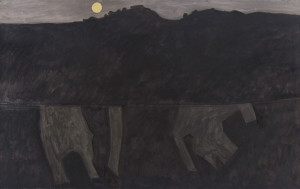

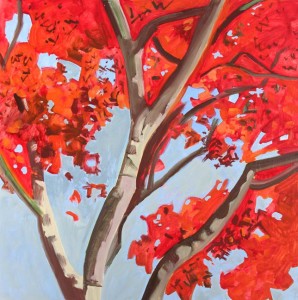
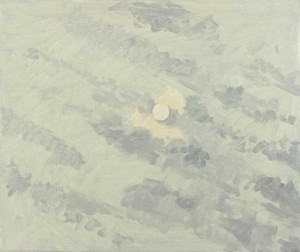
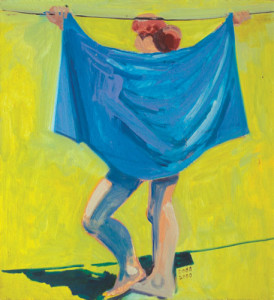
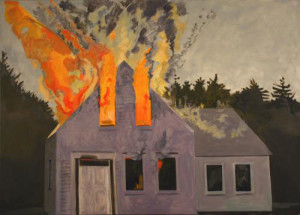

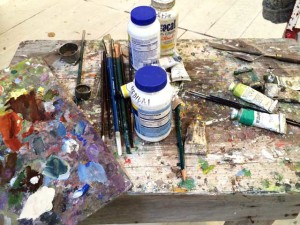
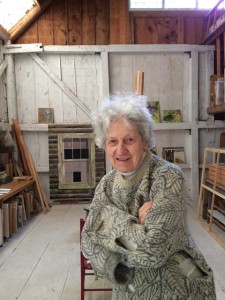




Well done for this, Larry! Lois Dodd is a wonderful artist and a heroine of painting. I know I’m going to really enjoy reading this interview.
Very nice interview. Thanks, Larry. I like Ms. Dodd’s differentiation between ‘painters’ and other artists in today’s art world. Hadn’t thought of it in quite those terms, but very true. We are a different breed, and do think entirely through paint. I do believe one can make a living out of one’s studio, though, through skill and industry. I see many young painters today succeeding at their craft.
Thank you so much for a really refreshing interview with wonderful and wise Lois !
Eskerrik asko elkarrizketa zoragarri eta argitsuren honengatik. Ona benetan!
Thanks Larry, Very good to hear her plainspoken words- no fanfare or great pronouncements, just the facts as she sees them.
And some good advice in there. – If you have to be a painter figure out how to support yourself…. Influences are great but not very useful, you have to make your own stuff!….Thoroughly enjoyed it. She is a role model on how a painting life is developed and maintained.
I will be sure to get by the Alexandre Gallery to see these paintings. I especially like Lois’s comment ‘Some people seem to get painting and some people don’t see it anyway, they could be surrounded by paintings and don’t really get it. Other people do. It’s an odd trait and it’s not universal.’
I get a visceral thrill from working with oil paint and looking at oil paintings. Nothing else quite does that for me. And I’m discovering that there really aren’t many painters out there…….a lot of artists but not many painters. Thank you so much Larry. Lois Dodd and Louisa Matthiasdottir are 2 of my favorite painters.
All best.
i enjoyed reading this very much. She is an amazing painter with a long and productive career…a living legend. Thanks!
I deeply admire Lois Dodd. It would have been fantastic had I studied with her, instead I have followed her from afar out here on the west coast. Enjoyed the interview so much. I identify with her very much, and hope if she ever sees my work she is not insulted at my presumption.Thank you for doing this intelligent interview
Larry, thanks for doing this interview. Lois is a major painter and her work should be much better known. And thanks for the heads up about the catalogue!
Larry, I thoroughly enjoyed this interview. I can feel particularly depressed, and the simple act of picking up a brush eases the distress. This mystical, meditative state, which is perfected in Lois, is sublime and a never ending reservoir of hope. Thank you
What a wonderful read to start the day! Another great conversation about painting…Thanks Larry.
Any insight into Lois’ painting process is like finding jewels for Lois Dodd is a treasure: both as a kindly and warm person as well as a brilliant painter. As a teacher, Lois honored the artist that was waiting to express through each and everyone of her students. She was both guide and facilitator. Thank you Larry for a wonderful interview with the quintessential painter, Lois Dodd.
Thank you for this very thoughtful interview. I received my MFA in Painting from Western Connecticut State University in 2006. Lois Dodd presented a lecture to our group and then visited one on one with each artist in her/his studio. I have always been grateful to Professors Margaret Grimes, John Wallace and Marjorie Portnow for their relationships in the New York art scene which benefitted us tremendously. Her critique was greatly appreciated. Best wishes to Lois Dodd for a continued joyful and healthy journey.
The love of painting exemplified in Lois’s work and in her comments are a wonderful tonic. Two tablespoonsful of her attitude prescribed before going into the studio! I feel honored to have met her and taken a couple of workshops with her.
Thank you for this wonderful and inspiring interview. It is reaffirming to hear that there is a difference between painters and “artists” and that beauty and joy have a place in this world. Lois Dodd speaks of many things that I often think about when painting. It is important when painting to be aware of (among other things) shape, color and the relationship of one thing to another. Lois Dodd’s paintings seem to do this in an effortless and intuitive way based on a life of painting and seeing. Reading this interview gives me optimism and inspiration as I begin a new painting today!
I stopped by the Alexandre Gallery to see the exhibition yesterday. When you first enter the foyer/reception area you see, on a shelf placed at eye level, several of the postcard sized aluminum flashing panels sitting side by side. They invite you to peer up close and are wonderful, fresh studies. The exhibition in the main gallery space has been hung with an attention to the various color keys that Dodd has explored with her thin paint and underlying geometric structure. It’s fascinating to see these paintings in ‘the flesh’ because you simultaneously take in the strong scaffolding structural design and architectonic, reductive form, explored with very fluid, sensitive brushwork. I am reminded of Paul Nash and Milton Avery. Definitely worth seeing in person.
Thanks for sharing this special interview with an inspirational and timeless painter. Wishing I could spend time painting with her.
As a colleague of Lois’ for twenty years I can say that she was almost universally loved and respected. Her directness and clarity was always apparent in her critiques, as it is in her painting. Her answers to your questions, her refusal to get bogged down in ideology exemplify this.
I have always been a big fan of Lois Dodd and especially love her paintings at the museum in Portland. Her name comes up a lot at Concord Art. I have gotten so many requests for her to teach here. Thank you for this wonderful interview.
I’m very glad to have found your blog and this interview, even if I’m late to the party!
I’m happy to report that Lois is going strong at 96 or 97 ( not really sure of her birthday.) I went in to the city for her reception at Alexandre this January. She’s still painting, although it’s mostly inside, paintings of bits of bark and nature that her son brings her.
I have been lucky enough to have known Lois since she came out to paint at our farm for the first time in the 1980s. I see her over the winter every month or so, and in Maine when I can get up there. I spent a week taking a workshop with Elizabeth O’Reilly a year ago or so ago that met in Lois’s Maine studio, in the midst of those iconic out buildings she loves to paint.
Seeing Lois is a rejuvenating experience, and despite her protestations that she is a painter, not a NY Artist with a capital A, she epitomizes what an artist is to me. There is nothing even slightly pretentious about her. I am honored to call her a friend.
In the meantime, I look forward to reading more on your site!
Will